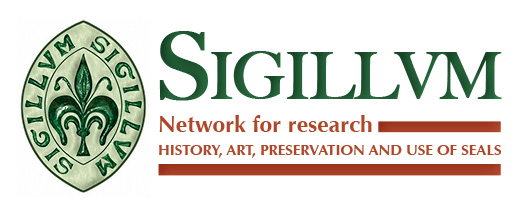Archives
Archival Collections of Seals
(Paul D.A. Harvey, Durham/UK)
An archive consists of documents – parchment, paper, electronic, whatever – accumulated in the normal course of affairs. It might be the deeds and other records of a long-established estate, or the files of a government department, or the papers, books and e-mails of a business, or the records of a society, or the letters, diaries and so on that we all have in our own homes. Any other assemblage of documents is technically not an archive but an artificial collection.
In many archives there are many seals. One thinks at once of those from the Middle Ages attached to the deeds owned by a long-established landed estate, or to the early administrative records of a kingdom, a city, an abbey or a cathedral. But there are many more. Seals are still used today for the ratification of a few – very few – types of formal document and sealed records of every period, and the matrices used to create them, are to be found in a surprising number of archives. In addition many archive repositories contain, for one reason or another, artificial collections of detached seals and casts.
It is unsurprising, then, that archivists take an interest in seals, though in the past their interest has been somewhat erratic. Some catalogues of documents describe seals in detail, but more only note their existence or do not mention them at all; some collections of detached seals and casts are described in detailed published catalogues, others are practically ignored.
It is therefore one of SIGILLVM’s main goals to support archivists in their work with seals and to bring them into contact with others interested in them. As the Provisional Section on Sigillography of the International Council on Archives will cease to exist in summer 2012, SIGILLVM encourages all its members to join the new network in order to form a strong and well supported group within the organisation.
Archivists’ Group within SIGILLVM
Members of SIGILLVM will need no persuading of the potential importance of seals as an historical and cultural record – nor do most archivists. The International Council on Archives set up a Committee on Sigillography in 1958 to raise the profile of seals among all those who look after documents and to promote good practice in storing, cataloguing and conserving them. Works published under its aegis include:
In 2004 all permanent committees of the International Council were abolished, but a new Provisional Section on Sigillography was set up. In practice it has proved impossible to meet the criteria to make this a permanent Section of the International Council, and it will automatically cease to exist from the summer of 2012. However, it is hoped that an Archivists’ Group within SIGILLVM will be able to carry on the work of the Committee and Provisional Section. Anyone registering as a member of SIGILLVM will be asked whether they are an archivist or other curator of seals; it is hoped that all who are will reveal this, so that from the start we can have a strong and well supported Archivists’ Group. While it cannot be a Committee or Section, it is expected that the Group will be associated in some way with the International Council, giving it professional links and professional status.
It is expected too that the Group will make a significant contribution to the work of SIGILLVM as a whole – and not least to this website.
